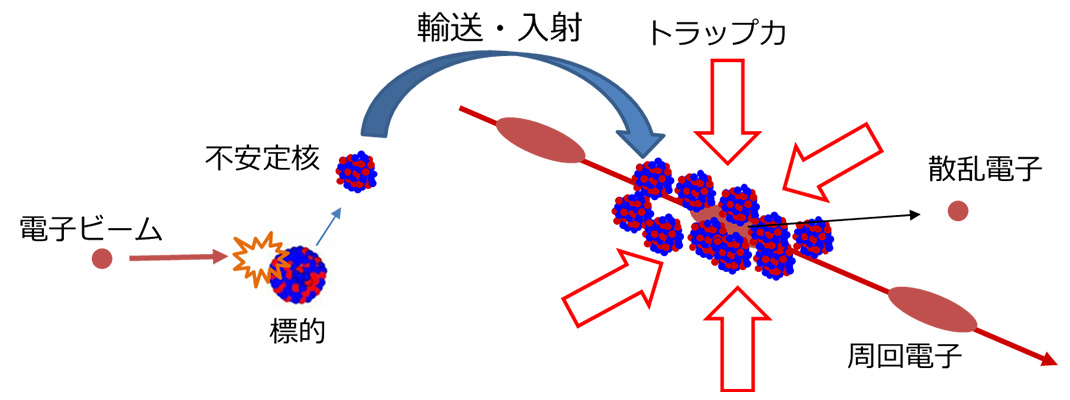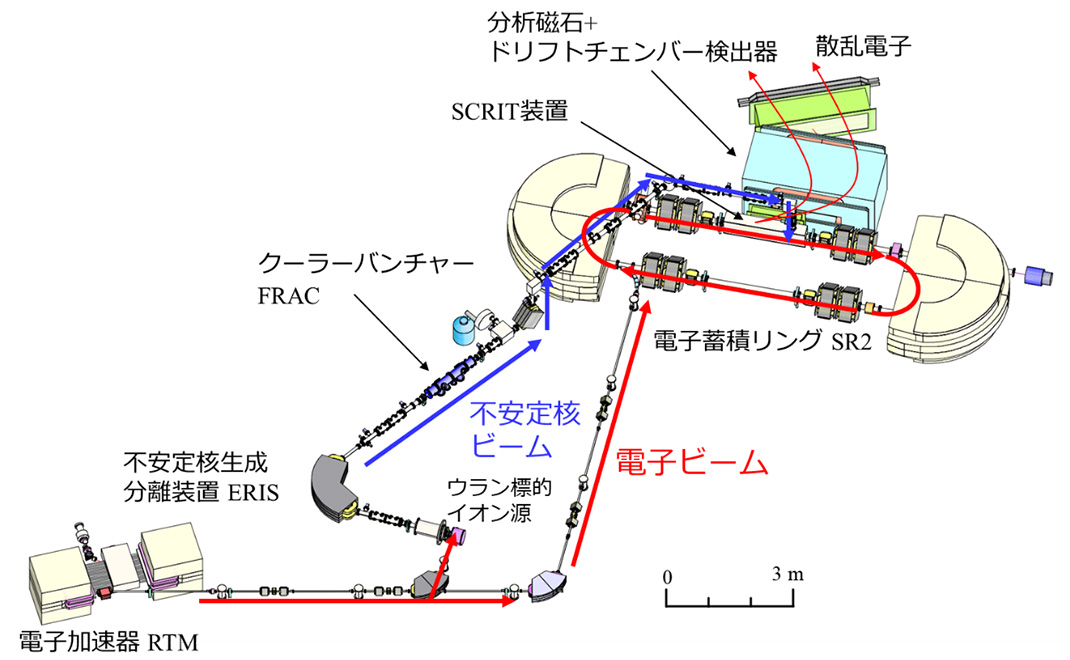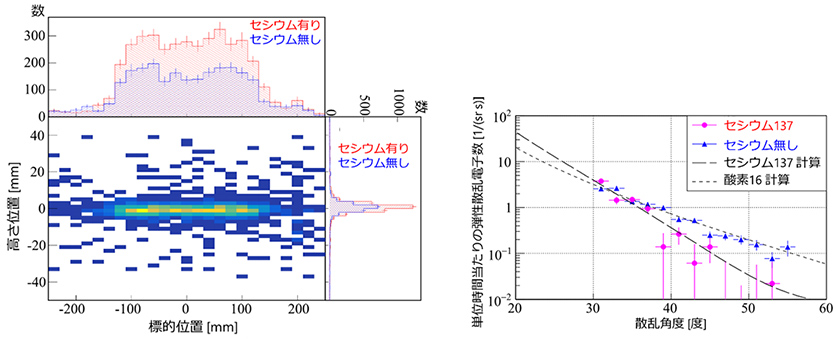Sep 01, 2023PRESS RELEASE
Successful electron scattering off unstable nuclei produced online
-Applying the SCRIT method to artificially generated unstable nuclei-
Keyword:RESEARCH
OBJECTIVE.
A joint research group that includes Tetsuya Onishi, the director of the instrumentation development group at RIKEN Nishina Center for Accelerator-Based Science, Professor Masanori Wakasugi of the Kyoto University Institute for Chemical Research, Professor Kazuyoshi Kurita of the Department of Physics at the Rikkyo University College of Science, and Professor Toshimi Suda of the Tohoku University Research Center for Electron Photon Science successfully conducted the first high-energy electron scattering experiment using the SCRIT method [1] with unstable nuclei [2] as the stationary targets, demonstrating it is possible to directly determine the proton distribution [3] of unstable nuclei.
The proton distribution of unstable nuclei is an important physical quantity that reflects their unique internal structure, which appears from the superposition wave functions [4] of its constituent protons. Scientists have long sought an experimental method using electron scattering that would enable them to directly observe this distribution. Conventional electron scattering methods require a stationary target with as many as 1020 unstable nuclei. To address this, the joint research group developed the SCRIT method and demonstrated in 2017 it is possible to conduct electron scattering experiments with a much smaller amount (107-108 nuclei).
In their study, the group developed techniques to convert unstable nuclei into a pulsed beam with nearly 100% efficiency, created an unstable nuclear stationary target using the SCRIT method, and successfully conducted electron scattering experiments on unstable nuclei. In the experiment, approximately 107/s ions of unstable nuclear cesium-137 (137Cs: 55 protons, 82 neutrons) were generated by irradiating a uranium target with an electron beam, and were guided into a SCRIT device [1] sitting inside SR2 electron storage ring [5]. The unstable nuclei acted as a floating stationary target via the SCRIT method, and electron scattering events were induced using a circulating electron beam of about 200-300 mA.
The study was published online in the journal "Physical Review Letters" on August 30.

Conceptual diagram of the experiment
Background
Electron scattering is a phenomenon in which electrons are modulated and rebound when they pass inside or near matter. Precisely analyzing modulated electrons allows researchers to make detailed studies of the internal structure of matter. In the field of nuclear research, high-energy electron scattering is a direct and highly accurate method for understanding the internal structure of atomic nuclei, especially the state of protons, because it is a well-understood phenomenon that is caused only by electromagnetic interactions. Further, because of its high reliability, it provides data that can be used in other experiments and for devising nuclear theories.
The measurement principles for this technique were developed more than half a century ago, and thanks to pioneering experiments on stable nuclei, a basic model of the nucleus has been established. Dr. Robert Hofstadter was awarded the Nobel Prize in Physics in 1961 for his work on this area. However, electron scattering experiments on unstable nuclei were not conducted for a long time. This was because it was difficult to create a stationary target with unstable nuclei.
To solve this problem, in 2008 the joint research group developed a method called self-confining RI ion target (SCRIT) that revolutionized electron scattering experiments (Fig. 1). The highly efficient targeting technique used in the SCRIT method makes it possible to conduct electron scattering experiments on a very small amount of targets. This research group spent about six years starting in 2009 establishing a SCRIT electron scattering facility at RIKEN Nishina Center for Accelerator-Based Science, and in 2017 they successfully performed an electron scattering experiment using SCRIT on a very small sample (about 108 nuclei) *1). They have been making progress on electron scattering experiments on unstable nuclei ever since.

Figure 1. Conceptual diagram of the SCRIT method
*1) June 28, 2017 press release: "Completion of a novel electron microscope for examining atomic nuclei"
Methods and Findings
The SCRIT electron scattering facility consists of a 150 MeV microtron RTM, which is an electron accelerator [9]; SR2 electron storage ring; and the ERIS device for generating and isolating unstable nuclei [10]. The SCRIT device is embedded into the straight part of SR2. SR2 stores an electron beam with an energy of 150-300 mega-electronvolts (MeV, 1 MeV = 1 million electron volts) and a current of 200-300 mA, which causes about 1018 electrons to pass through the SCRIT device every second.
Meanwhile, the uranium carbide target in the ERIS is irradiated by the electron beam output from the RTM. The unstable nuclei, which are fragments of uranium (92U), are extracted as an ion beam, and accumulated in the FRAC cooler/buncher [11] until a sufficient amount for measurement is reached, then are guided to the SCRIT device as a pulsed beam. Inside the SCRIT device, ions are trapped 3-dimensionally on the axis of the electron beam, turning them into floating targets. The electrons scattered by colliding with the target fly out of the electron storage ring and their direction, energy, and momentum are analyzed using an analyzing magnet [12] and drift chamber detectors [13] installed in front of and in behind the magnet. Information on the inside structure of the target nuclei is derived from the results of this analysis. Thus the SCRIT electron scattering facility can be seen as a kind of "giant electron microscope" that uses a small amount of unstable nuclei as its sample.

Figure 2. SCRIT electron scattering facility

Figure 3. Uranium carbide target and 137Cs pulsed beam observed with an oscilloscope
(Right) 137Cs pulsed beam waveform observed with an oscilloscope. The roughly 107 137Cs ions produced per second are stored in the FRAC for 4 seconds, then emitted as a 300 μs (μs:1 millionth of a second) width pulse and the charge is measured. When integrated, the charge quantity corresponds to 4×107 137Cs ions.
Figure 4 shows the distribution of these scattering points, indicating they had been scattered from the nuclei trapped around the electron beam. Experiments can be affected by the coexistence of residual gas [15] floating in a vacuum. To eliminate the impact of this, some measurements were performed on only residual gas without target ion injection. Figure 4 left shows the contribution (shaded blue) from residual gas. Figure 4 right shows the angular distribution of elastic scattering events for only 137Cs ions, after subtracting the influence of the residual gas. Plotted alongside the contribution from residual gas shows a clear difference in the angular distributions. This demonstrates that the events that were measured were scattered electrons from 137Cs ions.

Figure 4. Scattering position distribution and angular distribution
(Right) Angular distribution of elastic scattering events. The red dotted plot shows elastic scattering events from cesium ions, and the blue plot shows events from residual gas. The red and blue slopes are clearly different.
*2) T. Ohnishi et al., RIKEN Accel. Prog. Rep. 53, 110 (2020)
Future prospects
Going forward, the group plans to increase the beam power of the electron accelerator by 100 times to expand the capacity for generating unstable nuclei. This will allow them to measure the proton distribution of various types of unstable nuclei, which can help in the building of new nuclear models.
Moreover, obtaining a stationary target for unstable nuclei allowed them to present new methods for unstable nuclear research. This is expected to lead to new experiments on topics besides electron scattering that have also been facing roadblocks.
Article information
- <Title>
First observation of electron scattering from online-produced radioactive target
- <Authors>
Kyo Tsukada, Yasushi Abe, Akitomo Enokizono, Taiga Goke, Masahiro Hara, Yuki Honda, Toshitada Hori, Shinichi Ichikawa, Yuki Ito, Kazuyoshi Kurita, Clement Legris, Yoshiki Maehara, Tetsuya Ohnishi, Ryo Ogawara, Toshimi Suda, Tadaaki Tamae, Masanori Wakasugi, Masamitsu Watanabe, Hikari Wauke
- <Journal>
Physical Review Letters
- <DOI>
10.1103/PhysRevLett.131.092502
Footnotes
SCRIT (Self-Confining RI Ion Target) is a new method for target creation using an electron beam, and the SCRIT device is a target trapping apparatus that uses this method. A highly focused high-energy electron beam has a negative charge flow, while the target ions have a positive charge. Therefore, when target ions are placed in the vicinity of an electron beam, they are drawn into its stream. The target ions that are drawn in cannot escape. They concentrate along the path of the beam, where they are suspended. These suspended ions act as targets for electron scattering just as they are, which means that electron scattering events occur automatically. Because the electron beam performs better when the current is as large as possible, an electron storage ring is utilized. Moreover, electrostatic barrier voltage is applied in the beam direction so the trapped ions do not diffuse in the direction the electron beam is traveling. The SCRIT device is an electrode system installed inside an electron storage ring to generate this barrier voltage.
[2] High-energy electron scattering experiment
When investigating the properties of matter, a common method is to stimulate the matter and observe how it responds. One of these methods is electron scattering, in which an electron beam is used as a probe that collides with matter and the electrons that scatter as a result are observed. The energy of the electron beam must be optimized to the size of the matter being assessed. When observing microscopic objects like atomic nuclei, an energy level of at least 100 mega-electronvolts (MeV) is used. Scattering experiments using these kind of high-energy electron beams are called a high-energy electron scattering experiments.
[3] Proton distribution of unstable nuclei
A nucleus is composed of protons and neutrons, and the density distribution of a nucleus is determined from the superposition of the wave functions of individual particles. The mean proton and neutron density distributions are constant from the center to the surface (saturation of nuclear density) then decrease sharply when nearing the surface. This saturation partially breaks down for unstable nuclei. Theoretical predictions indicate that it swellingly seeps outward and/or creates densities in the center that differ from conventional nuclei. Therefore, it is important to conduct precise investigations of density distributions. Electron scattering is a way to study the density distribution of charged protons in detail and has long been pursued as an experimental technique in unstable nuclear research.
[4] Wave function
In quantum mechanics, the wave function shows the probability of a state. In this case, it indicates the probability for a certain particle to exist at a certain position. Superposition of the wave functions of the particles that make up the nucleus reveals the distribution of all these particles, which reflects the shape of the nucleus.
[5] SR2 electron storage ring
SR2 electron storage ring is a device with an electron beam circulating at high velocity inside a ring-shaped vacuum tube, which functions as both an accelerator and a trapping device. Beams circulate 10 million times per second inside the electron storage ring, which means a large current can be generated from only a small number of electrons, and it takes little power to maintain it. SR2 stands for SCRIT-equipped RIKEN Storage Ring.
[6] Halo, skin, new magic number
These are examples of the exotic properties of unstable nuclei. Typical halos and skins are neutron halos and neutron skins. A neutron halo is a state in which a small number (1-2) of neutrons are distributed over a larger area than the nucleus itself. A neutron skin represents the difference in the sizes of the neutron distribution and the proton distribution inside the nucleus overall. In exotic unstable nuclei, it represents a state in which only the neutron region spreads out to near the surface of the nucleus. A magic number is a particular number of protons or neutrons that reaches a stable state within the structure of an atomic nucleus. Magic numbers for stable nuclei include 2, 8, 20, 28, 50, 82, and 126. In unstable nuclei, especially neutron-excess nuclei with large numbers of neutrons, some of the magic numbers for stable nuclei disappear and new magic numbers appear. For example, 8, 20, and 28 disappear, while 16 and 34 appear.
See the October 18, 2019, press release, "Scientists confirm a new 'magic number' for neutrons"
https://www.riken.jp/en/news_pubs/research_news/pr/2019/20191018_2/index.html
[7] Nuclear force
This force binds the protons and neutrons that make up the nucleus to a very small region, and plays a dominant role in the formation of the structure of the nucleus.
[8] Online generation
In accelerator experiments, a beam is collided with a target to generate new nuclei to be studied. In particular, this is used to generate nuclei with short lifetime in real-time on the spot. The nuclei that are generated are guided from the generating device to the measuring device to be used in various experiments.
[9] RTM 150 MeV microtron electron accelerator
An accelerator that supplies an electron beam to SR2 storage ring and to the ion source to generate unstable nuclei at the SCRIT electron scattering facility. The 60 keV electron beam supplied by the electron gun accelerates while orbiting inside the magnet. One of its characteristics is that the trajectory of electrons passing through the accelerator tube does not change when they are accelerated. They accelerate by 6 MeV per lap, reaching 150 MeV in 25 laps, when they are deflected out. RTM is an abbreviation of "Racetrack Microtron".
[10] ERIS unstable nuclei generation and separation device
A device that includes both the target portion that generates unstable nuclei and the ion source. The low-energy RI beam supply device, which irradiates the target with a high-intensity beam, generates unstable nuclei from the target, analyzes the mass as an ion beam, and supplies it is called an ISOL (isotope separator for on-line). The target is heated up to about 2,000ºC, and the unstable nuclei that are generated can be quickly escaped from the target. After this, an ion beam is supplied from the ion source using an ionization method suited to the generated element. During this, the energy of the ion beam can range from several keV to several tens of keV. ERIS is short for electron-beam-driven RI separator for SCRIT.
[11] FRAC cooler/buncher
A device that can suppress the spread of ions using quadrupole electrodes when a high frequency is applied, which is capable of accumulating them within the device. What enters as a continuous beam can exit as a short-width pulsed beam. This lowers the internal potential as it approaches the exit. The inside of the device is filled with a buffer gas (about 10-3 Pa) so the energy of the accumulated ions is reduced to a value quickly. FRAC stands for fringing-RF-field-activated DC-pulse converter.
[12] Analyzing magnet
An electromagnet that analyzes electrons scattered from a target. It is installed close to the SCRIT device, so the scattered electrons ejected from the SCRIT device are bent by the force of the magnetic field. The momentum (energy) of these electrons can be analyzed by how they bend. In elastic scattering, which was examined in this study, it is essential to confirm that the energy of the scattered electrons is the same as the energy of the original beam. This is indispensable for this type of analysis. Because the distribution of the magnetic field has been thoroughly examined beforehand, the tracks of scattered electrons can be reproduced from the data of the drift chamber detector, which is described below.
[13] Drift chamber detector
A type of detector commonly used to observe the tracks of high-energy charged particles. A large number of wires are stretched over a container filled with a mixture of noble gases, organic compounds and other substances, and a fixed potential difference is maintained between the wires. When charged particles pass through the gas, the electrons generated by collisions with the gas are accelerated by this voltage when they drift inside the gas, and these collide with the gas to produce more electrons. This snowballing amplification effect which occurs in the vicinity of the wires causes the charge that has been generated to be absorbed by the wires, turning into a signal. By recording where these events occur, it is possible to reconstruct the tracks of the charged particles.
[14] Collaborative accumulation technique with ERIS and FRAC
This technique enables the conversion of ions into pulsed beams without loss by attaching an ion accumulation mechanism to the ERIS unstable nuclei generation and separation device and synchronizing the ion accumulation of the ERIS with that of the FRAC cooler/buncher. While the ions directed into FRAC are cooled (taking some tens of milliseconds), ions accumulate inside ERIS. Because the cooled ions do not escape from the FRAC, they can be retained while the ions accumulated in the ERIS are stacked. By performing this series of actions synchronously and repeatedly, it is possible to accumulate a large number of ions in the FRAC without loss, then extract them all at once as a pulsed beam.
[15] Residual gas
A vacuum contains minute amounts of neutral gases such as oxygen and hydrogen that cannot be removed. These gases seep out from the surfaces of the contents of the chamber and from the insides of the materials. The operating vacuum of the SCRIT device is about 10-8 Pa and is estimated to contain 3×106/cm3 of neutral gases. Considering the region where the ions are trapped, this corresponds to about 108/cm2 of the thickness of the electron scattering target.
Joint research group
- RIKEN Nishina Center for Accelerator-Based Science, department for experimental apparatus development
Tetsuya Ohnishi, director
Masamitsu Watanabe, full-time researcher
Yasushi Abe, cooperating researcher
Shinichi Ichikawa, part-time researcher (during the study)
Masahiro Hara, part-time researcher
Toshitada Hori, part-time researcher
- Kyoto University, Institute for Chemical Research
Masanori Wakasugi, professor
Kyo Tsukada, associate professor
Ryo Ogawara, assistant professor
Yoshiki Maehara, graduate student
Yuki Ito, graduate student
- Department of Physics, Rikkyo University College of Science
Kazuyoshi Kurita, professor
Shun Iimura, assistant professor
Akitomo Enokizono, researcher
- Tohoku University, Research Center for Electron Photon Science
Toshimi Suda, professor
Yuki Honda, assistant professor
Tadaaki Tamae, part-time researcher
Hikari Wauke, graduate student
Taiga Gouke, graduate student
Clement Legris, graduate student